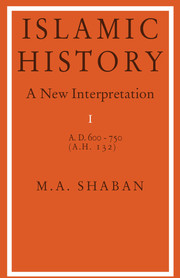Book contents
- Frontmatter
- Contents
- Acknowledgements
- Preface
- 1 The Islamic revolution in its environment
- 2 The emergence of Abū Bakr
- 3 ‘Umar and the conquests
- 4 The breakdown of the Madīnan regime
- 5 Mu‘āwiya and the second civil war
- 6 The age of Ḥajjāj
- 7 Moderate reform, radical reform and reaction: the reigns of Sulaymān, ‘Umar II and Yazīd II
- 8 Hishām: survival of the empire
- 9 The collapse of the Marwānids
- 10 The end of an era
- Works cited
- Index
3 - ‘Umar and the conquests
Published online by Cambridge University Press: 05 June 2012
- Frontmatter
- Contents
- Acknowledgements
- Preface
- 1 The Islamic revolution in its environment
- 2 The emergence of Abū Bakr
- 3 ‘Umar and the conquests
- 4 The breakdown of the Madīnan regime
- 5 Mu‘āwiya and the second civil war
- 6 The age of Ḥajjāj
- 7 Moderate reform, radical reform and reaction: the reigns of Sulaymān, ‘Umar II and Yazīd II
- 8 Hishām: survival of the empire
- 9 The collapse of the Marwānids
- 10 The end of an era
- Works cited
- Index
Summary
Before his death in 634/13 Abū Bakr designated ‘Umar b. al-Khaṭṭāb as his successor. In spite of the fact that this was an unprecedented act, it seemed the most natural thing for him to do, and its general acceptance by the community only shows that they had decided to continue the experiment begun with Abū Bakr. They probably felt that two years were not long enough for them to draw any mature conclusions about this system of government, even though the experiment, so far, had been a success. Abū Bakr's designation of ‘Umar was indeed an innovation, but it must be noted that it was made in the form of a recommendation, subject to the approval of the community. Indeed, there was nothing at all binding about it and the community could have rejected it had they wanted to do so. But ‘Umar was a man with great qualities of leadership and during Abū Bakr's reign his stature had grown fast. He was certainly influential in rallying the Madīnans to accept Abū Bakr as Khalīfa at a moment of supreme crisis and one must conclude that he was trusted by them. The Qurayshites had accepted Abū Bakr and there was no reason why they should oppose ‘Umar.
- Type
- Chapter
- Information
- Islamic HistoryA New Interpretation, pp. 28 - 59Publisher: Cambridge University PressPrint publication year: 1971



